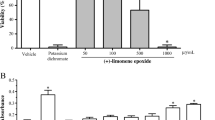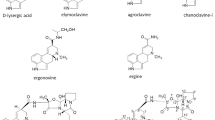Abstract
We have previously reported that in rats 2,3,7,8-tetrachlorodibenzo-p-dioxin (TCDD) lethality is associated (although not necessarily causally) with changes in brain serotonin (5-HT) metabolism. In the present study, we have examined whether this holds for other species by comparing the effect of TCDD in the most TCDD-susceptible and the most TCDD-resistant species, guinea pigs and hamsters, respectively. Body weight gain of guinea pigs exposed to TCDD (0.3–2.7 μg/kg) diminished dose dependently, while the effect was marginal in hamsters (900–4600 μg/kg). Brain 5-hydroxyindoleacetic acid (the main metabolite of brain 5-HT), brain tryptophan (the precursor amino acid of 5-HT), and plasma free and total tryptophan were not affected at any dose in guinea pigs. In contrast, 4 days after exposure, the levels of plasma free and total tryptophan were consistently increased in hamsters. These, as well as brain tryptophan, were still elevated 10 days after exposure. TCDD did not affect plasma glucose level in either species. Liver glycogen was decreased in a dose-dependent manner in TCDD-treated guinea pigs as well as in their pair-fed controls on day 10. There was no change in liver glycogen in hamsters. The activity of the gluconeogenic enzyme, phosphoenolpyruvate carboxykinase was only depressed in hamsters by all doses of TCDD. We conclude that changes in tryptophan metabolism or in carbohydrate homeostasis cannot explain the wide interspecies differences in susceptibility to the acute lethality of TCDD, although they may correlate with some aspects of its toxicity in certain species.
Similar content being viewed by others
References
Fan F, Rozman K (1994) Relationship between acute toxicity of 2,3,7,8-tetrachlorodibenzo-p-dioxin (TCDD) and disturbance of intermediary metabolism in the Long-Evans rat. Arch Toxicol 69: 73–78
Foster DO, Ray PD, Lardy HA (1966) A paradoxical in vivo effect of l-tryptophan on the phosphoenoylpyruvate carboxykinase of rat liver. Biochemistry 5: 563–569
Hultman E (1967) Muscle glycogen in man determined in needle biopsy specimens. Method and normal values. Scand J Clin Lab Invest 19: 209–217
Kelling CK, Christian BJ, Inhorn SL, Peterson RE (1986) Hypophagia-induced weight loss in mice, rats, and guinea-pigs treated with 2,3,7,8-tetrachlorodibenzo-p-dioxin. Fundam Appl Toxicol 5: 700–712
McMenamy RH, Oncley JL (1958) The specific binding of l-tryptophan to serum albumin. J Biol Chem 233: 1436–1447
Oguri K, Hatsumura M, Ishii Y, Koga Y, Ariyoshi N, Yoshimura H (1993) Modification of the gluconeogenesis is not involved in the co-planar PCB toxicity in highly sensitive guinea pigs. Chemosphere 27: 2295–2303
Olson JR, Holscher MA, Neal RA (1980) Toxicity of 2,3,7,8-tetrachlorodibenzo-p-dioxin in the golden Syrian hamster. Toxicol Appl Pharmacol 55: 67–78
Pohjanvirta R, Tuomisto J (1994) Short term toxicity of 2,3,7,8-tetrachlorodibenzo-p-dioxin (TCDD) in laboratory animals: effects, mechanisms, and animal models. Pharmacol Rev 46: 483–549
Pohjanvirta R, Unkila M, Tuomisto J (1993) Comparative acute lethality of 2,3,7,8-tetrachlorodibenzo-p-dioxin (TCDD), 1,2,3,7,8-pentachlorodibenzo-p-dioxin and 1,2,3,4,7,8-hexachlorodibenzo-p-dioxin in the most TCDD-susceptible and the most TCDD-resistant rat strain. Pharmacol Toxicol 73: 52–56
Rozman K, Pfeifer B, Kerecsen L (1991) Is a serotonergic mechanism involved in 2,3,7,8-tetrachlorodibenzo-p-dioxin (TCDD) induced appetite suppression in the Sprague Dawley rat? Arch Toxicol 124: 124–128
Schwetz B, Norris J, Sparschu G, Rowe V, Gehring P, Emerson J, Gerbig C (1973) Toxicology of chlorinated dibenzo-p-dioxins. Environ Health Perspect 5: 87–99
Söling H-D, Williams B, Kleineke J, Gehlhoff M (1970) Regulation of gluconeogenesis in the guinea-pig liver. Eur J Biochem 16: 289–302
Unkila M, Pohjanvirta R, Tuomisto JT, Tuomisto J (1995) Alterations in plasma tryptophan binding to albumin in 2,3,7,8-tetrachlorodibenzo-p-dioxin-treated Long-Evans rats. Eur J Pharmacol (in press)
Unkila M, Pohjanvirta R, MacDonald E, Tuomisto J (1992) Differential effect of TCDD on brain serotonin metabolism in a TCDD-susceptible and a TCDD-resistant rat strain. Chemosphere 27: 401–406
Unkila M, Pohjanvirta R, MacDonald E, Tuomisto J (1994a) Characterization of 2,3,7,8-tetrachlorodibenzo-p-dioxin (TCDD)-induced brain serotonin metabolism in the rat. Eur J Pharmacol 270: 157–166
Unkila M, Pohjanvirta R, MacDonald E, Tuomisto JT, Tuomisto J (1994b) Dose response and time course of alterations in tryptophan metabolism by 2,3,7,8-tetrachlorodibenzo-p-dioxin (TCDD) in the most TCDD-susceptible and the most TCDD-resistant rat strain: relationship with TCDD lethality. Toxicol Appl Pharmacol 128: 280–292
Veneziale CM, Walter P, Kneer N, Lardy HA (1967) Influence of l-tryptophan and its metabolite on gluconeogenesis in isolated, perfused liver. Biochemistry 7: 2129–2138
Weber LDW, Lebofsky M, Greim H, Rozman K (1991a) Key enzymes of gluconeogenesis are dose dependently reduced in 2,3,7,8-tetrachlorodibenzo-p-dioxin (TCDD)-treated rats. Arch Toxicol 65: 119–123
Weber LDW, Lebofsky M, Stahl BU, Gorski JR, Muzi G, Rozman K (1991b) Reduced activities of key enzymes of gluconeogenesis as a possible cause of acute toxicity of 2,3,7,8-tetrachlorodibenzo-p-dioxin (TCDD) in rats. Toxicology 66: 133–144
Wimmer M (1988) A bioluminescent assay for the determination of phosphoenoylpyruvate carboxykinase activity in nanogramsized tissue samples. Anal Biochem 170: 376–381
Author information
Authors and Affiliations
Rights and permissions
About this article
Cite this article
Unkila, M., Ruotsalainen, M., Pohjanvirta, R. et al. Effect of 2,3,7,8-tetrachlorodibenzo-p-dioxin (TCDD) on tryptophan and glucose homeostasis in the most TCDD-susceptible and the most TCDD-resistant species, guinea pigs and hamsters. Arch Toxicol 69, 677–683 (1995). https://doi.org/10.1007/s002040050231
Received:
Accepted:
Issue Date:
DOI: https://doi.org/10.1007/s002040050231




